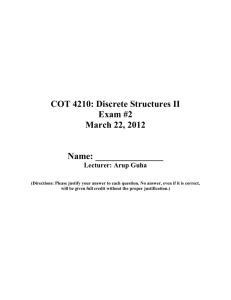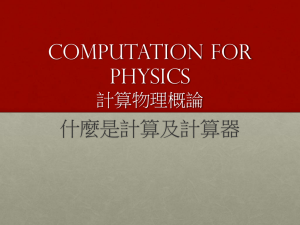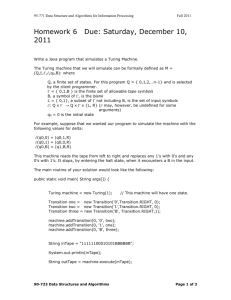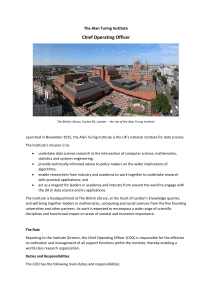state
advertisement
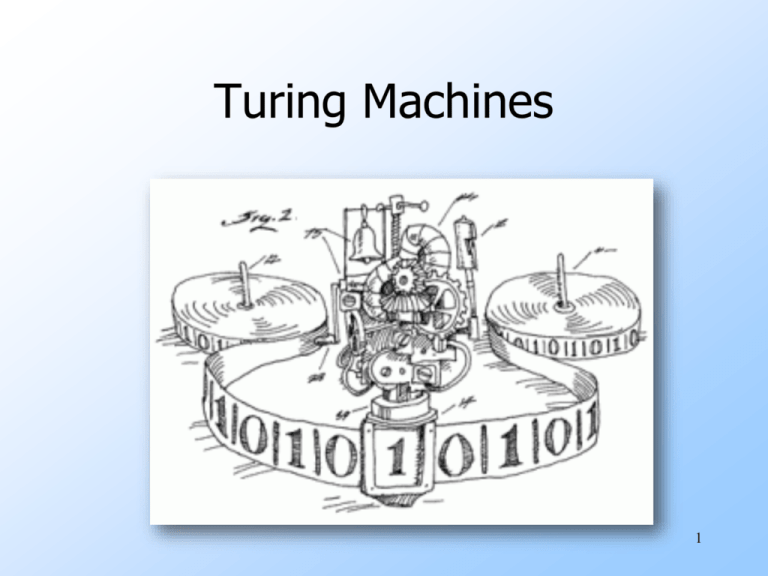
Turing Machines
1
Turing-Machine Theory
The purpose of the theory of Turing
machines is to prove that certain
specific languages have no algorithm.
Reductions are used to prove more
common questions are undecidable.
2
Turing Machines
Regular and CF languages are both recognized by a
particular type of machine.
Regular: Finite Automata (Deterministic, Nondeterministic).
Context Free: Pushdown Automata.
Both types of machine are limited.
Regular: No memory.
Context Free: A restricted type of memory (first-in, last-out).
Neither model is acceptable as a general model of
computation
Clearly some machine should be able to recognize strings in
{w#w|w ∈ {0, 1}* } (which is not a CFL).
Turing Machines (TMs) are.
They are the canonical model for computation. To be
computable means to be computable by a Turing Machine
3
Picture of a Turing Machine
Action: based on
the state and the
tape symbol under
the head: change
state, rewrite the
symbol and move the
head one square.
State
...
A
B
C
A
D
...
Infinite tape with
squares containing
tape symbols chosen
from a finite alphabet
4
Why Turing Machines?
Why not deal with C programs or
something like that?
Answer: You can, but it is easier to prove
things about TM’s, because they are so
simple.
And yet they are as powerful as any
computer.
• More so, in fact, since they have infinite memory.
5
Finite automata to Turing
Machines
A Turing machine can both write on the
tape and read from it
The read write head can move both to
left and right
The tape is infinite
Once accept/reject states are reached,
the computation terminates at once
6
Turing-Machine Formalism
A TM is described by:
1.
2.
3.
4.
A finite set of states (Q, typically).
An input alphabet (Σ, typically).
A tape alphabet (Γ, typically; contains Σ).
A transition function (δ, typically).
5. A start state (q0, in Q, typically).
6. A blank symbol (B, in Γ- Σ, typically).
All tape except for the input is blank initially.
7. A set of final states (F ⊆ Q, typically).
7
The Transition Function
Takes two arguments:
1. A state, in Q.
2. A tape symbol in Γ.
δ(q, Z) is either undefined or a triple of
the form (p, Y, D).
p is a state.
Y is the new tape symbol.
D is a direction, L or R.
8
Actions of the TM
If δ(q, Z) = (p, Y, D) then, in state q,
scanning Z under its tape head, the
TM:
1. Changes the state to p.
2. Replaces Z by Y on the tape.
3. Moves the head one square in direction D.
D = L: move left; D = R; move right.
9
Example: Turing Machine
This TM scans its input right, looking
for a 1.
If it finds one, it changes it to a 0, goes
to final state f, and halts.
If it reaches a blank, it changes it to a
1 and moves left.
10
Example: Turing Machine – (2)
States = {q (start), f (final)}.
Input symbols = {0, 1}.
Tape symbols = {0, 1, B}.
δ(q, 0) = (q, 0, R).
δ(q, 1) = (f, 0, R).
δ(q, B) = (q, 1, L).
11
Simulation of TM
δ(q, 0) = (q, 0, R)
δ(q, 1) = (f, 0, R)
δ(q, B) = (q, 1, L)
q
... B B 0 0 B B ...
12
Simulation of TM
δ(q, 0) = (q, 0, R)
δ(q, 1) = (f, 0, R)
δ(q, B) = (q, 1, L)
q
... B B 0 0 B B ...
13
Simulation of TM
δ(q, 0) = (q, 0, R)
δ(q, 1) = (f, 0, R)
δ(q, B) = (q, 1, L)
q
... B B 0 0 B B ...
14
Simulation of TM
δ(q, 0) = (q, 0, R)
δ(q, 1) = (f, 0, R)
δ(q, B) = (q, 1, L)
q
... B B 0 0 1 B ...
15
Simulation of TM
δ(q, 0) = (q, 0, R)
δ(q, 1) = (f, 0, R)
δ(q, B) = (q, 1, L)
q
... B B 0 0 1 B ...
16
Simulation of TM
δ(q, 0) = (q, 0, R)
δ(q, 1) = (f, 0, R)
δ(q, B) = (q, 1, L)
f
... B B 0 0 0 B ...
No move is possible.
The TM halts and
accepts.
17
Example 2
B = {w#w | w Є {0,1}*
Repeatedly do: Mark the first “unmarked”
symbol from the beginning and zig-zag across
the tape to its corresponding position on the
other side of the # to check if they are same
(need to remember what you see). If so mark,
otherwise reject
Stop when there are no unmarked symbols
remaining to the left of #. If there are still
symbols left on the right, reject. Else accept.
18
19
δ
0
1
#
B
x
q0 (start)
(q1,x,R)
(q2,x,R)
(q3,#,R)
q_rej
(q0,x,R)
q1 (see 0)
(q1,0,R)
(q1,1,R)
(q4,#,R)
q_rej
(q1,x,R)
q2 (see 1)
(q2,0,R)
(q2,1,R)
(q5,#,R)
q_rej
(q2,x,R)
q3 (left input q_rej
finished)
q_rej
q_rej
q_acc
(q3,x,R)
q4 (match 0) (q6,x,L)
q_rej
q_rej
q_rej
(q4,x,R)
q5 (match 1) q_rej
(q6,x,L)
q_rej
q_rej
(q5,x,R)
q6 (go back)
(q6,1,L)
(q6,#,L)
(q0,B,R)
(q6,x,L)
(q6,0,L)
20
Instantaneous Descriptions of
a Turing Machine
Initially, a TM has a tape consisting of a
string of input symbols surrounded by
an infinity of blanks in both directions.
The TM is in the start state, and the
head is at the leftmost input symbol.
21
TM ID’s – (2)
An ID is a string q, where is the
tape between the leftmost and
rightmost nonblanks (inclusive).
The current state q is immediately to
the left of the head (tape symbol
scanned).
If q is at the right end, it is scanning B.
22
TM ID’s – (3)
As for PDA’s we may use symbols ⊦ and
⊦* to represent “becomes in one move”
and “becomes in zero or more moves,”
respectively, on ID’s.
Example: The moves of the previous TM
are q00⊦0q0⊦00q⊦0q01⊦00q1⊦000f
23
ID’s for w#w
Initial tape: …BB01#01BB…
q001#01 ⊦ xq11#01 ⊦* x1#q401
⊦x1#q6x1 ⊦* q0x1#x1 ⊦* xxq2#x1
⊦* xx#q5x1 ⊦x1#xq6x ⊦* q0xx#xx
⊦* xx#q3xx ⊦* xx#xxqacc
24
Languages of a TM
A Turing Machine M defines a language
by final state, as usual.
L(M) = {w | q0w⊦*I, where I is an ID
with a final state}.
L(M), language of M (the language
recognized by M), is the set of strings
accepted by M
25
Recursive vs Recursively
Enumerable
Turing recognizable or Recursively
enumerable
A language is Turing recognizable or
Recursively Enumerable if there is a Turing
machine accepting it
Turing decidable or recursive
A language is decidable (or recursive) if
there is a Turing machine accepting it,
which has the additional property that it
halts on all possible inputs
26
Recursive vs Recursively
Enumerable
It is possible for a TM to never reach a
halting configuration. It might instead
infinitely loop
there are 3 outcomes: accept, reject, loop
If TM accepts or rejects for all inputs then it
is a decidable (recursive) language.
Every decidable lang. is R.E. but not the
converse
27
Decidability
decidable
undecidable
all languages
regular
languages
context free
languages
RE
decidable RE all languages
28
Extentions to Turing Machine
Multitape TM
Nondeterministic TM
Multihead TM
Multistack PDA
All are equivalent, any language
accepted by a TM is accepted by any of
them and vice versa
29
30


